10 Best Brewing Malts for Perfect Beer Every Time
I’ve selected ten exceptional brewing malts that consistently produce superior beer results. For extract brewers, Briess Pilsen and Traditional Dark dry malt extracts provide reliable foundations, while their liquid versions offer enhanced flavor depth. All-grain brewers benefit from quality 2-row base malts and specialty options like Vienna malt for complexity, plus Caramel 80L for sweetness and color. These malts balance enzyme activity, flavor contribution, and brewing reliability across different methods. Continue exploring to discover specific applications and brewing techniques for each variety.
We are supported by our audience. When you purchase through links on our site, we may earn an affiliate commission, at no extra cost for you. Learn more. Last update on 13th November 2025 / Images from Amazon Product Advertising API.
Notable Insights
- Base malts like 2-row and 6-row provide essential fermentable sugars and enzymes for starch conversion during mashing.
- Light malts (1-10°L) deliver crisp, bready flavors while darker malts (20-500°L) contribute chocolate and coffee notes.
- Specialty malts should comprise 5-20% of grain bill to shape flavor and appearance without overpowering base characteristics.
- German, French, Danish, and English malts offer superior quality due to established processing methods and regional expertise.
- Match malt selection to brewing method – all-grain requires high diastatic power, extract brewing focuses on specialty grains.
Briess Dried Malt Extract- Pilsen- 3 Lb.
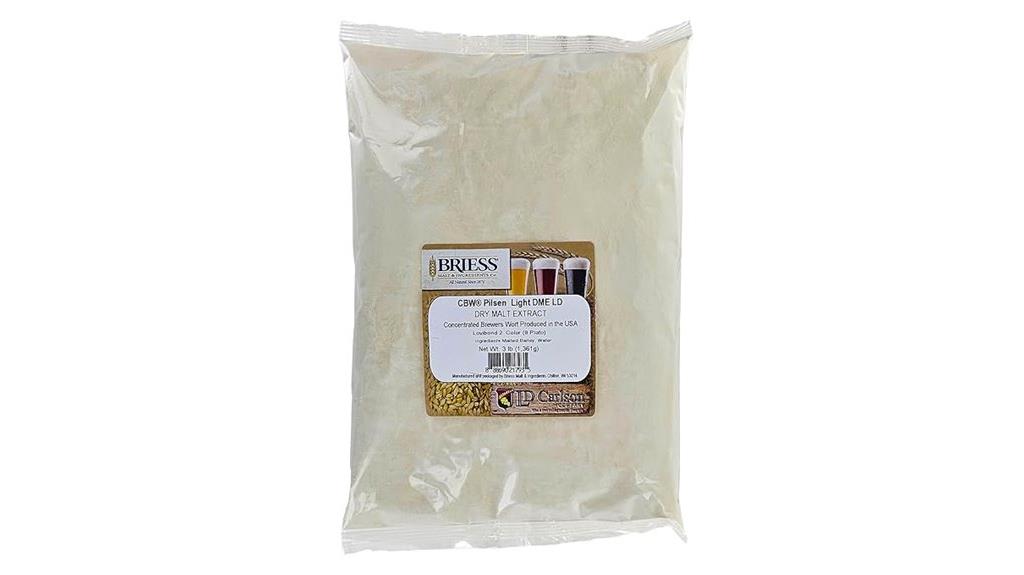
If you’re brewing light lagers, wheat beers, or pale ales, Briess Dried Malt Extract in Pilsen offers the cleanest foundation for your recipes. At just 2.0 °L, it’s the lightest-colored malt extract available, giving you maximum control over your beer’s final appearance. You’ll get consistent results from this American-made blend of Pilsen Malt and CarapilsA Malt, which provides excellent fermentable sugars without adding unwanted flavors. Use it alone for crisp, clean beers, or combine it with specialty malts to create complex flavor profiles. The 3-pound bag gives you enough extract for multiple batches, and it’s perfect for boosting gravity when needed.
Best For: Homebrewers making light lagers, wheat beers, and pale ales who want the cleanest, lightest-colored malt extract base without unwanted flavors.
Pros:
- Lightest color available at 2.0 °L provides maximum control over beer appearance
- Clean fermentable sugars from quality Pilsen and CarapilsA malt blend without off-flavors
- Versatile for use alone or with specialty malts, plus effective for gravity boosting
Cons:
- Limited to light-colored beer styles when used as primary extract
- 3-pound bag may be excessive for brewers making only single batches
- Lacks the character and complexity that liquid malt extracts can provide
2-Row Brewers Malt for Home Brewing Whole Grain 10lbs
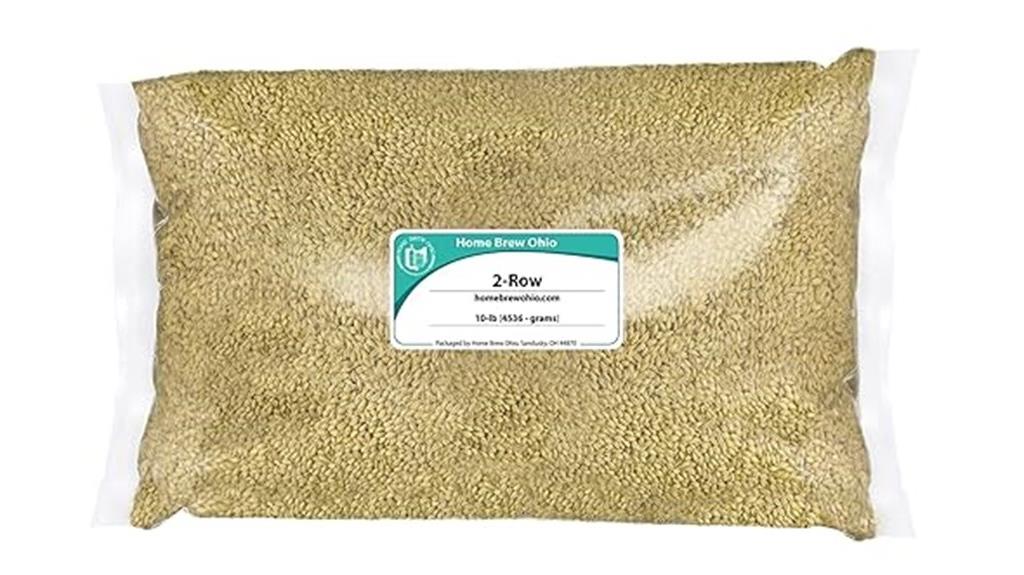
The 2-Row Brewers Malt stands as the cornerstone choice for home brewers who demand consistent results and superior flavor profiles in their all-grain or partial mash brewing projects. You’ll discover this whole grain malt delivers excellent extraction rates while providing smoother, less grainy flavors compared to 6-row alternatives. The well-modified grain contains high enzyme levels, making single-step infusion mashes effortless for converting starches to fermentable sugars. You should consider adding a protein rest during mashing to improve your beer’s clarity and appearance. This United States-sourced base malt offers higher yields and slightly lower protein content than 6-row varieties, ensuring consistent brewing performance every time.
Best For: Home brewers who want a reliable base malt for all-grain or partial mash brewing with smooth flavor profiles and high extraction rates.
Pros:
- Higher extraction rate and yield compared to 6-row malt
- Well-modified with high enzyme levels for easy single-step infusion mashing
- Produces smoother, less grainy flavors than 6-row alternatives
Cons:
- Requires a protein rest step to achieve optimal clarity in finished beer
- Limited to base malt applications rather than specialty brewing uses
- 10lb quantity may be excessive for small-batch or occasional brewers
Briess Traditional Dark Dry Malt Extract 3lbs, Beige (1794B)
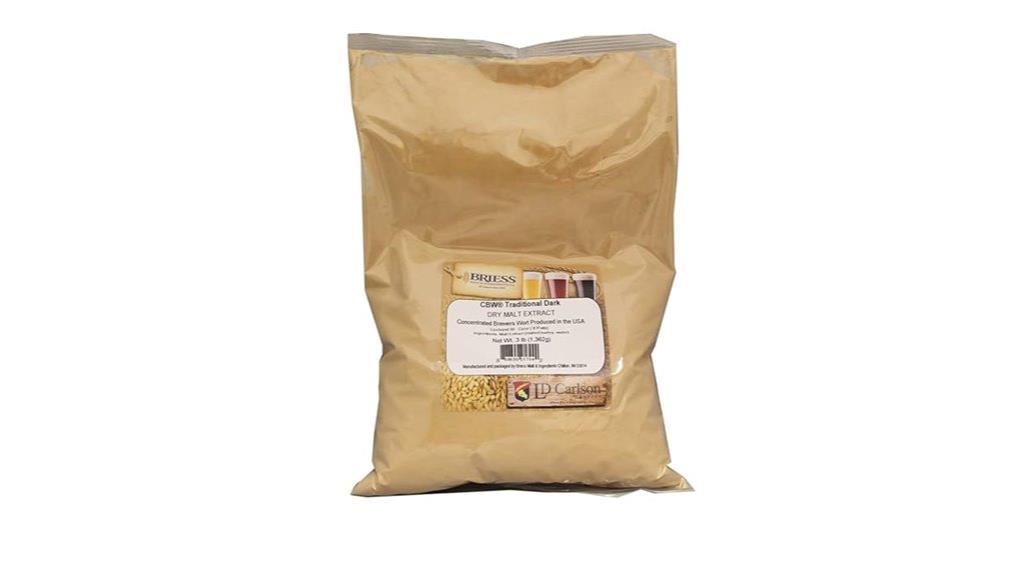
Serious homebrew enthusiasts who want to craft darker beer styles will find Briess Traditional Dark Dry Malt Extract an excellent foundation for their recipes. This 3-pound package combines Munich malt, 2-row barley malt, caramel 60L malt, and black malt to create complex flavors. You’ll appreciate its versatility for both extract and all-grain brewing methods, whether you’re creating full recipes or adjusting gravity and color. One bag provides enough base for a strong 5-gallon batch when combined with honey and specialty grains. You can easily incorporate this extract into porters, stouts, and other darker styles that require rich malt character.
Best For: Serious homebrew enthusiasts who want to craft darker beer styles like porters and stouts or need to adjust color and gravity in their extract and all-grain recipes.
Pros:
- Versatile blend of Munich malt, 2-row barley, caramel 60L, and black malt creates complex flavors for darker beer styles
- Works for both extract and all-grain brewing methods, offering flexibility in recipe development
- One 3-pound bag provides sufficient base for a strong 5-gallon batch when combined with other ingredients
Cons:
- Not suitable for bread making applications due to weak taste, color, and aroma compared to baking-specific malt products
- Limited to darker beer styles, making it less versatile for lighter beer recipes
- May require additional specialty grains and adjuncts to achieve desired flavor complexity in some recipes
Briess U.S. Brewers Malt for Beer Making & Home Brewing (Caramel 80L)
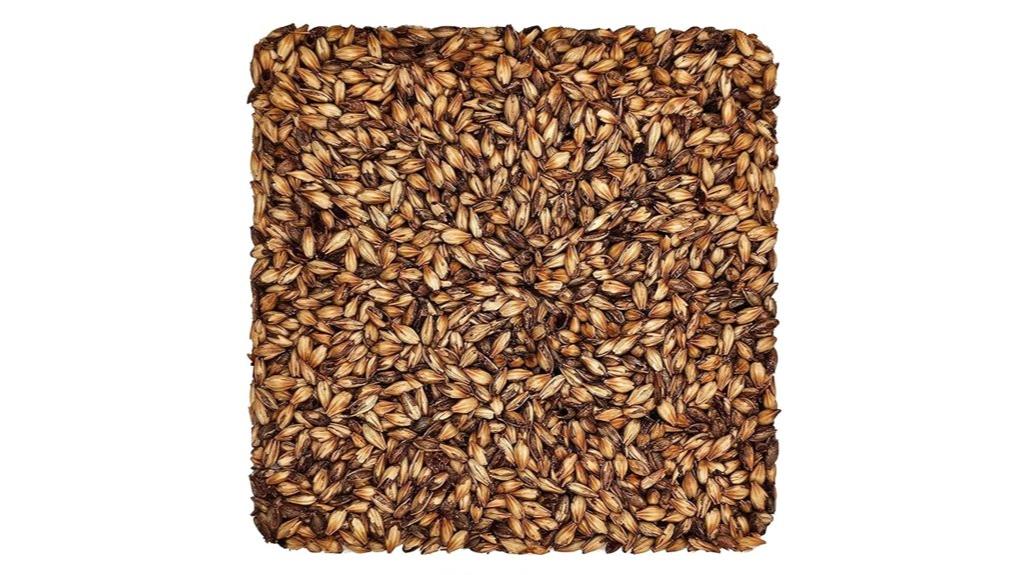
Home brewers seeking rich caramel complexity will find Briess U.S. Brewers Malt delivers exceptional results with its 80 Lovibond rating. This specialty grain contributes pronounced caramel flavors with subtle burnt sugar notes and raisiny undertones. You’ll achieve red to deep red coloring in your finished beer while adding sweet, smooth caramel character to your brew.
The 1-pound package provides enough grain for multiple batches, making it cost-effective for regular brewing. You can use this caramel malt as a specialty addition to enhance base malts in various beer styles. It works particularly well in amber ales, porters, and stouts where caramel complexity enhances the overall flavor profile without overwhelming other ingredients.
Best For: Home brewers who want to add rich caramel complexity and deep red coloring to amber ales, porters, stouts, and other beer styles requiring pronounced caramel character.
Pros:
- Delivers exceptional caramel flavor with subtle burnt sugar and raisiny notes at 80 Lovibond rating
- Cost-effective 1-pound package provides enough grain for multiple brewing batches
- Versatile specialty grain that enhances base malts without overwhelming other flavor components
Cons:
- Limited to specialty use only and cannot serve as a base malt for complete grain bills
- May produce overly intense caramel flavor if used in excessive quantities
- Not suitable for lighter beer styles where subtle flavors are preferred
My Brew Supply Premium Vienna Malt Beer Making Grain (10lb Crushed Grain)

Brewers seeking authentic German-style lagers and robust American ales will find exceptional value in My Brew Supply’s Premium Vienna Malt, which delivers the distinctive flavor profile that defines these classic beer styles. This 6-row Vienna malt comes from premium European barley grown in Germany, France, Denmark, and England, ensuring consistent quality and authentic character. You’ll receive 10 pounds of pre-crushed grain that’s ready for immediate use in your mash tun. The malt provides strong yet smooth flavor with beautiful golden color, and you can use it at 100% for German lagers, Kolsch, Alts, and American ales, or as a flavorful base for darker beer styles.
Best For: Home brewers who want to create authentic German-style lagers, Kolsch, Alts, and American ales with a premium 6-row Vienna malt that provides strong flavor and beautiful golden color.
Pros:
- Made from premium European barley sourced from established grain-growing regions in Germany, France, Denmark, and England for consistent quality
- Pre-crushed and ready to use immediately, saving time and effort in the brewing process
- Versatile enough to use at 100% for light beer styles or as a flavorful base for darker ales and stouts
Cons:
- Limited to 6-row barley variety, which may not suit brewers who prefer 2-row malt characteristics
- 10-pound bag size may be too large for small-batch brewers or those wanting to experiment with smaller quantities
- Pre-crushed grain has a shorter shelf life compared to whole grain malt and must be used relatively quickly
RiteBrew 812325 Briess – Dry Malt Extract – Golden Light – 3 lbs.
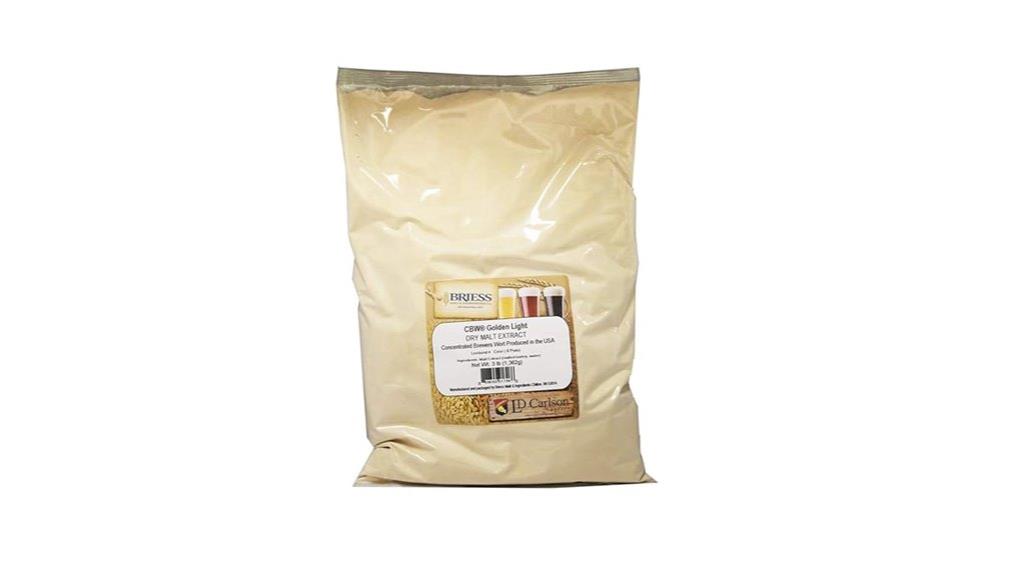
When you need a reliable foundation for your brewing projects, RiteBrew 812325 Briess Dry Malt Extract delivers consistent results that both beginners and experienced brewers can count on. This 3-pound package contains 100% pure malted barley extract made from pilsen malt and carapils malt, giving you a clean, crisp taste without clumping issues.
You’ll appreciate how easily this DME dissolves when you add it slowly to boiling water, reducing scorching risks. Use half a cup per liter of water for starter cultures, or incorporate it directly into your wort for partial mash ales. The oxygen barrier packaging keeps your extract stable during storage, maintaining freshness until you’re ready to brew.
Best For: Home brewers of all experience levels who want a reliable, pure malted barley extract for creating starter cultures, partial mash ales, or enhancing existing worts with consistent flavor and quality.
Pros:
- Made from 100% pure malted barley extract with pilsen malt and carapils malt for clean, crisp taste
- Dissolves easily without clumping and reduces scorching risk when added slowly to boiling water
- Oxygen barrier packaging maintains freshness and stability during storage
Cons:
- Limited to golden light color profile, restricting use in darker beer styles
- Requires careful heating technique to prevent scorching during preparation
- At 2.85 lbs actual weight, you get slightly less product than the advertised 3 lb package size
Briess CBW® Traditional Dark LME Single Canister 3.3 lb (1328)
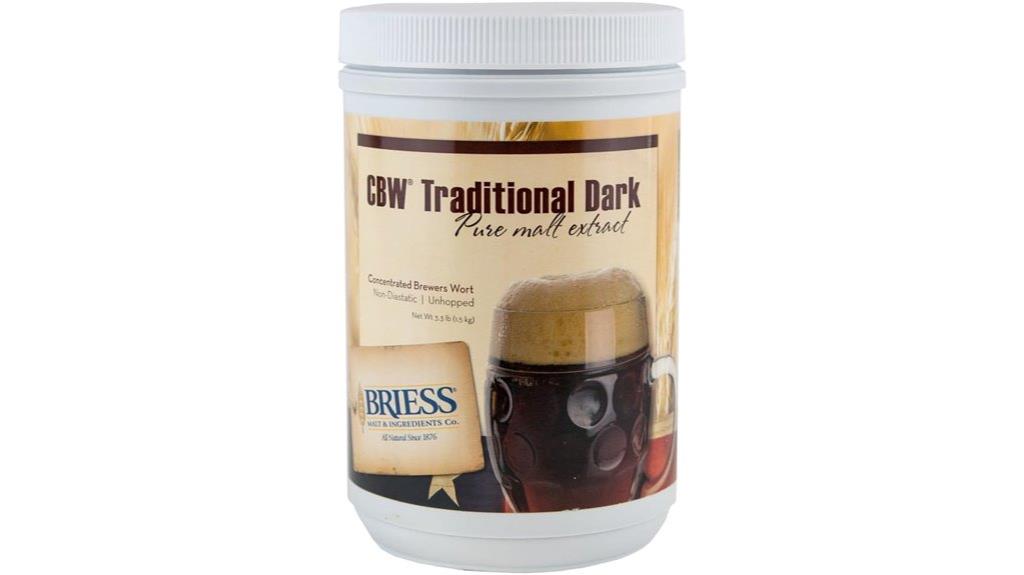
Advanced homebrewers seeking rich malty complexity will find the Briess CBW® Traditional Dark LME Single Canister delivers exceptional depth through its 54% Munich Malt 10L composition. You’ll experience sweet, intense malty flavors that enhance darker beer styles like porters and stouts. This 3.3-pound liquid extract comes in recyclable steel cans, measuring 4 x 4 x 6.5 inches for convenient storage. The extract promotes more vigorous fermentation while producing cleaner malt aromas compared to standard extracts. Briess crafts this product from finest quality 2-row barley, ensuring consistent color profiles and flavor integrity. You’re getting brewery-quality extract that simplifies complex brewing processes.
Best For: Advanced homebrewers who want to create rich, complex darker beer styles like porters and stouts with authentic malty depth and professional-quality results.
Pros:
- Contains 54% Munich Malt 10L for exceptional sweet, intense malty flavors that enhance darker beer styles
- Promotes more vigorous fermentation and cleaner malt aromas compared to standard extracts
- Crafted from finest quality 2-row barley by brewery professionals, ensuring consistent color profiles and flavor integrity
Cons:
- Higher price point compared to basic malt extracts due to premium Munich malt composition
- Limited to darker beer styles, making it less versatile for lighter ales or lagers
- 3.3-pound single canister may not provide enough extract for larger batch brewing projects
Briess 2-Row Brewers Malt For Home Brewing-50 Lbs.

Home brewers who want to master all-grain brewing will find Briess 2-Row Brewers Malt an excellent foundation for their beer recipes. This 50-pound base malt delivers clean, sweet, mild malty flavors with a light straw color ranging from 1.6 to 2.2 Lovibond. You’ll appreciate its versatility across beer styles, from brown ales and Irish reds to IPAs. The bulk size proves far more economical than buying smaller quantities for individual batches. You can even toast portions of the grain to alter color and flavor profiles for specific brews, giving you complete control over your final product.
Best For: Home brewers who want to learn all-grain brewing techniques and need an economical, versatile base malt for making multiple batches of various beer styles.
Pros:
- Economical bulk pricing that’s far cheaper than buying smaller quantities for individual batches
- Versatile base malt that works well across multiple beer styles including brown ales, Irish reds, and IPAs
- Can be toasted to alter color and flavor profiles, giving brewers complete control over their final product
Cons:
- Ships without protective boxing, which can be problematic for certain locations like Hawaii
- 50-pound quantity may be excessive for casual or infrequent brewers
- Requires all-grain brewing knowledge and equipment, making it unsuitable for extract brewing methods
Craft a Brew Dry Malt Extract (1.25 Pounds Traditional Dark)
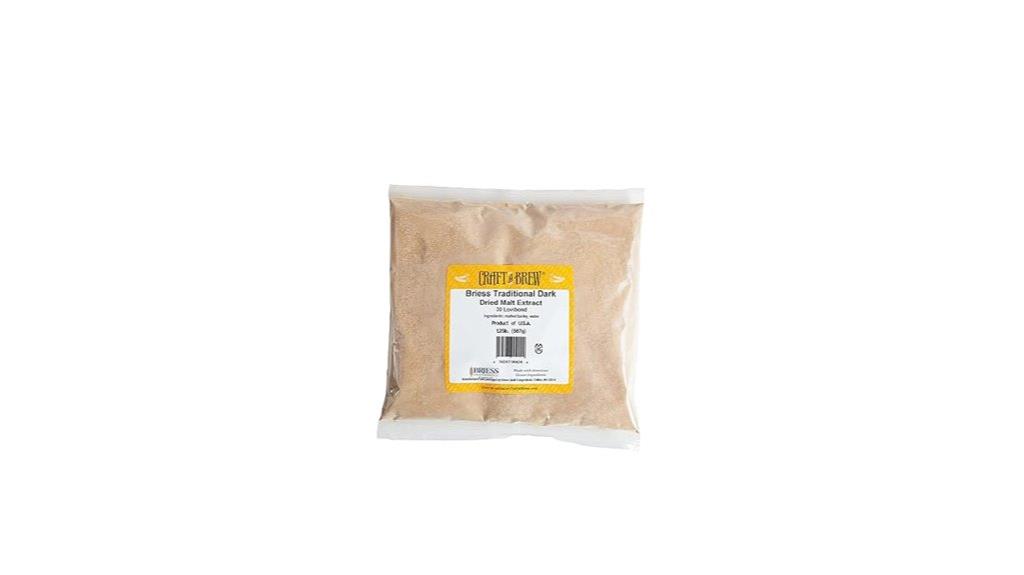
Craft A Brew’s Traditional Dark Dry Malt Extract delivers concentrated brewing power in a convenient 1.25-pound package, making it the exemplary choice for brewers who want consistent results without the time-intensive process of all-grain brewing. You’ll get high-quality fermentation every time with this all-purpose base extract made from malted wheat and malted barley. The concentrated brewers wort uses U.S.-grown ingredients that are custom fresh-packed for ideal flavor and effectiveness. You can use this traditional dark extract for any beer style, giving you versatility in your brewing experiments while maintaining reliable quality standards.
Best For: Home brewers who want consistent, high-quality results without the complexity and time requirements of all-grain brewing while maintaining flexibility to create various beer styles.
Pros:
- Made with U.S.-grown malted wheat and barley that’s custom fresh-packed for optimal flavor and fermentation effectiveness
- Versatile all-purpose base extract that works for any beer style, giving brewers flexibility in their recipes
- Convenient 1.25-pound size provides concentrated brewing power while eliminating the time-intensive mashing process
Cons:
- Limited to traditional dark flavor profile which may not suit brewers wanting lighter colored beers
- Extract brewing generally produces less complex flavors compared to all-grain brewing methods
- Smaller 1.25-pound package size may require multiple units for larger batch brewing projects
Factors to Consider When Choosing Brewing Malts
When I’m selecting brewing malts for my next batch, I consider five critical factors that directly impact my beer’s final character and quality. The malt’s color specification determines my beer’s appearance, while choosing between base and specialty malts affects the foundation versus accent flavors in my recipe. I also evaluate whether to use extract or grain, assess how each malt’s flavor profile fits my target style, and research the origin and quality standards of my malt suppliers.
Malt Color Specifications
The Lovibond scale serves as brewing’s universal language for measuring malt color, ranging from pale 1°L Pilsner malts to intensely dark 500°L roasted varieties. I use this system to predict both visual appearance and flavor contributions in my final beer. Light malts between 1-10°L deliver crisp, bready characteristics perfect for lagers and pale ales. When I need deeper flavors, I reach for darker specialty malts ranging from 20-500°L that provide chocolate, coffee, and roasted notes.
Understanding these specifications lets me control my beer’s color precisely. I calculate the weighted average of all malts in my grain bill to estimate final beer color. The kilning and roasting intensity directly correlates with the Lovibond rating, making this scale invaluable for recipe formulation and consistency.
Base Vs Specialty
Successful recipe formulation depends on understanding the fundamental difference between base and specialty malts in your grain bill. Base malts like 2-row and 6-row barley form your beer’s backbone, providing 80-100% of fermentable sugars with clean, light flavors. They contain the enzymes needed for starch conversion during mashing.
Specialty malts work differently. Caramel malts add sweetness and color, while roasted malts contribute coffee or chocolate notes. I use specialty malts at 5-20% of my total grain bill to shape flavor and appearance without overwhelming the base malt character.
Your malt selection directly impacts your beer’s style. A pale ale needs mostly base malt with light specialty additions, while a stout requires significant roasted malt percentages. Balance these components thoughtfully to achieve your target flavor profile.
Extract Vs Grain
Extract and grain brewing represent two distinct paths that shape your entire brewing experience and final beer quality. Extract malts are pre-cooked, concentrated syrups that provide ready-to-use fermentable sugars, making brewing simpler with less equipment required. You’ll get predictable, uniform flavors but with limited customization options. All-grain brewing requires mashing grains to convert starches into fermentable sugars, demanding more time, equipment, and technical skill. However, you’ll gain complete control over mash parameters and uncover complex malt characteristics that extracts can’t deliver. Partial mash brewing offers a middle ground, combining extract’s simplicity with specialty grains for added flexibility. Consider your experience level, available time, and desired flavor complexity when choosing your approach.
Flavor Profile Impact
When crafting your perfect beer, malt selection becomes the cornerstone that determines whether you’ll achieve a light, crisp lager or a rich, complex stout. I’ll show you how different malts create specific flavor profiles in your brew.
Base malts like Pilsner provide clean, neutral foundations, while Munich and Vienna malts add toasted, bread-like complexity. Darker malts transform your beer’s character tremendously. Chocolate malt delivers intense coffee notes, and black malt contributes sharp roasted flavors perfect for porters and stouts.
The proportion matters greatly. Using 10% chocolate malt creates subtle hints, but 20% dominates the flavor profile. Caramel malts contribute sweetness ranging from light honey (40L) to deep toffee (120L). I recommend starting with small percentages of specialty malts, then adjusting based on your taste preferences.
Origin and Quality
Just as terroir affects wine grapes, the geographic origin of your brewing malts directly influences their quality and flavor characteristics. I’ve found that malts from established regions like Germany, France, Denmark, and England consistently deliver superior results. These regions have perfected their growing conditions and processing methods over centuries.
When I select malts, I pay close attention to how they’re processed. High-quality producers carefully preserve enzymes while developing the desired malt characteristics through controlled kilning temperatures. The variety and processing method you choose will greatly impact your beer’s color, flavor, and fermentation properties.
Proper storage matters too. I always check that my malts haven’t been exposed to excessive heat, moisture, or oxygen, which can compromise their brewing potential and freshness.
Brewing Method Compatibility
Your brewing method determines which malts will work best for your recipe. All-grain brewers need base malts like 2-row and 6-row that contain sufficient diastatic power for complete starch conversion during mashing. These malts provide the enzymes necessary to break down starches into fermentable sugars. Extract and partial mash brewers can focus more on specialty malts since their base sugars come from malt extract. When choosing malts, consider protein content‘s impact on your final beer. Lower protein malts like 2-row work best for clear, light-colored beers, while higher protein options suit darker styles. Match your malt selection to your equipment and experience level for consistent results every time.
Package Size Considerations
Most home brewers overlook package size when selecting malts, yet this decision drastically impacts both your budget and brewing flexibility. I’ve found that 10 or 50 lb bags offer significant cost savings per pound compared to smaller 1-3 lb packages. If you’re an experienced brewer with adequate storage space, larger bags make economic sense for base malts like Pilsner or Pale Ale malt. However, smaller bags work better for occasional brewers or those with limited storage capacity. I recommend buying specialty malts in smaller quantities since you’ll use less of them per batch. Your package size choice should balance cost-effectiveness, storage capacity, and your typical batch sizes for ideal brewing economics.
Frequently Asked Questions
How Long Do Brewing Malts Stay Fresh After Opening the Package?
I recommend using opened brewing malts within 6-12 months for best results. Store them in airtight containers in cool, dry places below 70°F to maintain freshness. Base malts typically last longer than specialty malts, which can lose flavor more quickly. You’ll notice stale malts smell musty or lack their characteristic aroma. Properly stored malts won’t spoil but will gradually lose flavor intensity over time.
Can I Substitute Liquid Malt Extract for Dry Malt Extract Recipes?
Yes, I can substitute liquid malt extract for dry malt extract in recipes. Use 1.25 pounds of liquid extract for every pound of dry extract called for. Liquid extract contains about 20% water, so you’ll need more to achieve the same sugar content. Reduce your recipe’s water by roughly 0.25 pounds per substitution to maintain proper consistency and gravity.
What’s the Difference Between Crushed and Whole Grain Malts for Brewing?
I recommend using crushed malts for extract brewing since they’re pre-milled and ready to steep. Whole grain malts require you to crush them yourself using a grain mill, which gives you fresher flavor but adds an extra step. Crushed malts lose freshness faster, so use them within a few weeks. Whole grains stay fresh for months when stored properly in cool, dry conditions.
Do I Need to Mill My Own Grains or Buy Pre-Crushed?
I recommend buying pre-crushed grains if you’re starting out or brewing infrequently. Pre-crushed saves time and guarantees consistent results without equipment investment. However, I’d suggest milling your own if you brew regularly or want maximum freshness. Whole grains stay fresh for months, while crushed malts lose quality within weeks. A basic grain mill costs around $60-150 and pays for itself through better flavor and grain storage flexibility.
How Much Malt Extract Should I Use per Gallon of Beer?
I recommend using 6-7 pounds of liquid malt extract or 4.5-5.5 pounds of dry malt extract per 5 gallons for a standard-strength beer (around 5% ABV). For one gallon, that’s 1.2-1.4 pounds of liquid extract or 0.9-1.1 pounds of dry extract. Start with these amounts, then adjust based on your desired alcohol content and beer style preferences.
On a final note
I’ve covered the top brewing malts that’ll help you create exceptional beer at home. Whether you’re starting with extract brewing or moving to all-grain, these malts offer reliable quality and consistent results. Remember to match your malt choice to your beer style, consider flavor profiles carefully, and store grains properly. Start with simpler extracts if you’re new, then experiment with specialty grains as your skills develop.
